目录
一.shiro授权角色,权限
数据库表中的数据
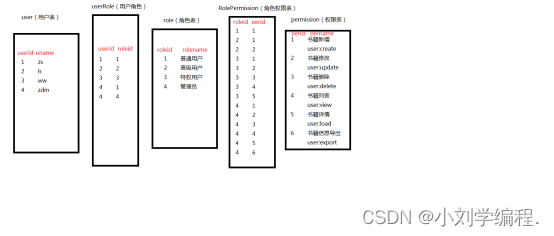
授角色:用户具备哪些角色
sql查询语句:
elect r.roleid from t_shiro_user u,t_shiro_user_role ur,t_shiro_role r
where u.userid = ur.userid and ur.roleid = r.roleid
and u.username = #{userName}授权限:用户具备哪些权限
sql查询语句:
select p.perid from t_shiro_user u,t_shiro_user_role ur,t_shiro_role_permission rp,t_shiro_permission p
where u.userid = ur.userid and ur.roleid = rp.roleid and rp.perid = p.perid
and u.username = #{userName}1.1 Mapper层,Servlce层
UserMapper.xml
角色
<select id="selectRoleIdsByUserName" resultType="java.lang.String" parameterType="java.lang.String">
select r.roleid from t_shiro_user u,t_shiro_user_role ur,t_shiro_role r
where u.userid = ur.userid and ur.roleid = r.roleid
and u.username = #{userName}
</select>
权限
<select id="selectParIdsByUserName" resultType="java.lang.String" parameterType="java.lang.String">
select p.perid from t_shiro_user u,t_shiro_user_role ur,t_shiro_role_permission rp,t_shiro_permission p
where u.userid = ur.userid and ur.roleid = rp.roleid and rp.perid = p.perid
and u.username = #{userName}
</select>UserMapper
package com.ljj.ssm.mapper;
import com.ljj.ssm.model.User;
import org.apache.ibatis.annotations.Param;
import org.springframework.stereotype.Repository;
import java.util.Set;
@Repository
public interface UserMapper {
int deleteByPrimaryKey(Integer userid);
int insert(User record);
int insertSelective(User record);
User selectByPrimaryKey(Integer userid);
//通过 账户名 查询用户信息
User queryUserByUserName(@Param("userName") String userName);
//通过 账户名 查询对应的角色信息
Set<String> selelctRoleIdsByUserName(@Param("userName") String userName);
//通过 账户名 查询对应的权限信息
Set<String> selelctPerIdsByUserName(@Param("userName") String userName);
int updateByPrimaryKeySelective(User record);
int updateByPrimaryKey(User record);
}UserBiz:
package com.ljj.ssm.biz;
import com.ljj.ssm.model.User;
import java.util.Set;
public interface UserBiz {
int deleteByPrimaryKey(Integer userid);
int insert(User record);
int insertSelective(User record);
User selectByPrimaryKey(Integer userid);
User queryUserByUserName(String userName);
int updateByPrimaryKeySelective(User record);
int updateByPrimaryKey(User record);
//通过 账户名 查询对应的角色信息
Set<String> selelctRoleIdsByUserName(String userName);
//通过 账户名 查询对应的权限信息
Set<String> selelctPerIdsByUserName(String userName);
}UserBizImpl:
package com.ljj.ssm.biz.impl;
import com.ljj.ssm.biz.UserBiz;
import com.ljj.ssm.mapper.UserMapper;
import com.ljj.ssm.model.User;
import org.springframework.beans.factory.annotation.Autowired;
import org.springframework.stereotype.Service;
import java.util.Set;
@Service("userBiz")
public class UserBizImpl implements UserBiz {
@Autowired
private UserMapper userMapper;
@Override
public int deleteByPrimaryKey(Integer userid) {
return userMapper.deleteByPrimaryKey(userid);
}
@Override
public int insert(User record) {
return userMapper.insert(record);
}
@Override
public int insertSelective(User record) {
return userMapper.insertSelective(record);
}
@Override
public User selectByPrimaryKey(Integer userid) {
return userMapper.selectByPrimaryKey(userid);
}
@Override
public User queryUserByUserName(String userName) {
return userMapper.queryUserByUserName(userName);
}
@Override
public int updateByPrimaryKeySelective(User record) {
return userMapper.updateByPrimaryKeySelective(record);
}
@Override
public int updateByPrimaryKey(User record) {
return userMapper.updateByPrimaryKey(record);
}
@Override
public Set<String> selelctRoleIdsByUserName(String userName) {
return userMapper.selelctRoleIdsByUserName(userName);
}
@Override
public Set<String> selelctPerIdsByUserName(String userName) {
return userMapper.selelctPerIdsByUserName(userName);
}
}1.2 授权的方法
/**
* 授权
* @param principals
* @return
* 这个方法替代了shiro-web.ini
* 菜单
*/
@Override
protected AuthorizationInfo doGetAuthorizationInfo(PrincipalCollection principals) {
// 获取账户名
String userName = principals.getPrimaryPrincipal().toString();
// 查询对应的角色
Set<String> role = userBiz.selelctRoleIdsByUserName(userName);
// 查询用户对应的权限
Set<String> per = userBiz.selelctPerIdsByUserName(userName);
// 拿到授权器
SimpleAuthorizationInfo info = new SimpleAuthorizationInfo();
// 将当前的登录的权限交给shiro授权器
info.setStringPermissions(per);
// 将当前的登录的角色交给shiro授权器
info.setRoles(role);
return info;
}applicationContext-shiro.xml配置文件中对我们角色进行修改 因为我们sql查询出来的是id
只有角色为4的才可访问
只有权限含2的才可访问
测试:
角色授权:
使用张三登陆,张三角色为1
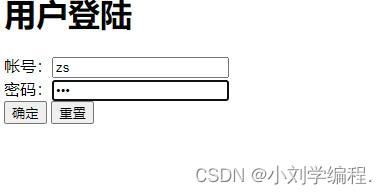
访问页面:
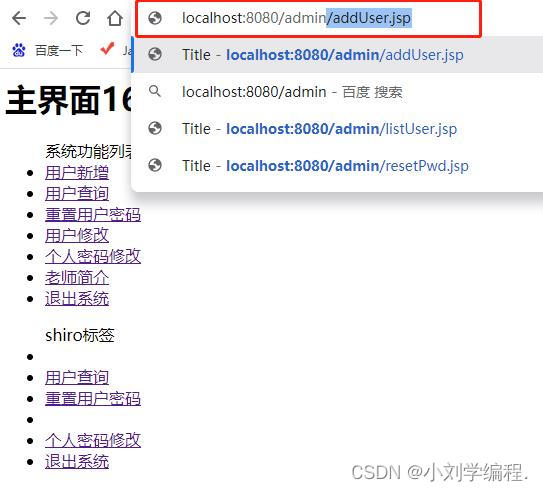
结果:

使用角色为4 的zdm登陆
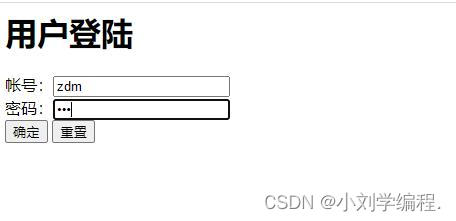
访问同样的界面
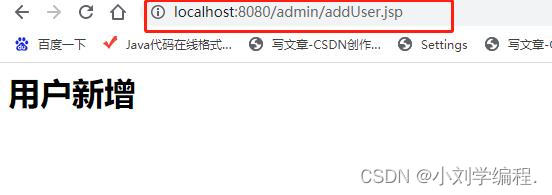
权限授权:
继续使用zdm访问权限限制的页面 zdm角色无2权限
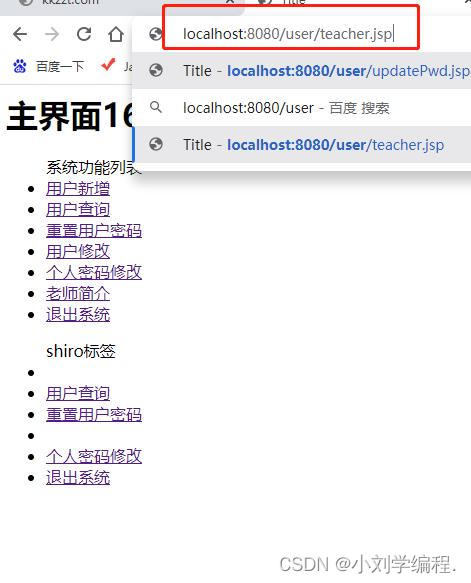
结果:
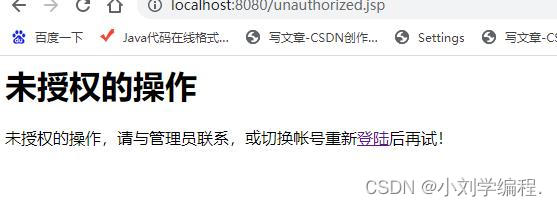
使用含有2权限的ls进行登陆和访问:

访问:
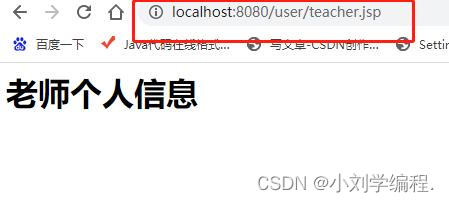
授权操作成功!!!
二,Shiro的注解式开发
常用注解介绍:
@RequiresAuthenthentication:表示当前Subject已经通过login进行身份验证;即 Subject.isAuthenticated()返回 true
@RequiresUser:表示当前Subject已经身份验证或者通过记住我登录的
@RequiresGuest:表示当前Subject没有身份验证或者通过记住我登录过,即是游客身份
@RequiresRoles(value = {"admin","user"},logical = Logical.AND):表示当前Subject需要角色admin和user
@RequiresPermissions(value = {"user:delete","user:b"},logical = Logical.OR):表示当前Subject需要权限user:delete或者user:b
今天只使用以下两个注解
@RequiresRoles(value = {"admin","user"},logical = Logical.AND):表示当前Subject需要角色admin和user
@RequiresPermissions(value = {"user:delete","user:b"},logical = Logical.OR):表示当前Subject需要权限user:delete或者user:b
Springmvc-servlet.xml
<bean class="org.springframework.aop.framework.autoproxy.DefaultAdvisorAutoProxyCreator"
depends-on="lifecycleBeanPostProcessor">
<property name="proxyTargetClass" value="true"></property>
</bean>
<bean class="org.apache.shiro.spring.security.interceptor.AuthorizationAttributeSourceAdvisor">
<property name="securityManager" ref="securityManager"/>
</bean>
<bean id="exceptionResolver" class="org.springframework.web.servlet.handler.SimpleMappingExceptionResolver">
<property name="exceptionMappings">
<props>
<prop key="org.apache.shiro.authz.UnauthorizedException">
unauthorized
</prop>
</props>
</property>
<property name="defaultErrorView" value="unauthorized"/>
</bean>ShiroController:
将对应注解添加到制定需要权限控制的方法上
身份认证:RequiresUser
角色认证:RequiresRoles
权限认证:RequiresPermissions
添加注解之前要在springmvc.xml中添加拦截器相关配置
package com.ljj.ssm.controller;
import org.apache.shiro.authz.annotation.Logical;
import org.apache.shiro.authz.annotation.RequiresPermissions;
import org.apache.shiro.authz.annotation.RequiresRoles;
import org.apache.shiro.authz.annotation.RequiresUser;
import org.springframework.stereotype.Controller;
import org.springframework.web.bind.annotation.RequestMapping;
import javax.servlet.http.HttpServletRequest;
@RequestMapping("/shiro")
@Controller
public class ShiroController {
// RequiresUser代表当前方法只有登录后才能访问
@RequiresUser
@RequestMapping("/passUser")
public String passUser(HttpServletRequest request){
System.out.println("身份认证通过....");
return "admin/addUser";
}
@RequiresRoles(value = {"1","4"},logical = Logical.AND)
@RequestMapping("/passRole")
public String passRole(HttpServletRequest request){
System.out.println("角色认证通过....");
return "admin/listUser";
}
@RequiresPermissions(value = {"2"},logical = Logical.AND)
@RequestMapping("/passPer")
public String passPer(HttpServletRequest request){
System.out.println("权限认证通过....");
return "admin/resetPwd";
}
}